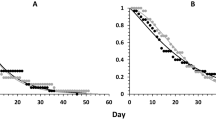Summary
This study compares the host-parasite relation betweenColeophora ? alcyonipennella andAgathis sp., on the one hand, andUrophora spp. andEurytoma tibialis, on the other hand.Coleophora-Agathis is a striking example for a host-parasite relation where the larval development of the parasitoid is controlled by the endocrine system of the host, which results in an optimal synchronization between the life-cycles of the moth and its specialized Braconid parasite. Attempts to obtain adultAgathis during the winter season for the biological control ofColeophora in New Zealand have met with considerable difficulties because of the hormonal dependence of the parasite on the host. The rearing and the transfer of adult parasites was not possible until the diapause of the host could be ended experimentally. In the complexUrophora-E. tibialis the parasite larvae interferes with the hormonal system controlling the development of the host. In hibernating generations ofUrophora spp. the parasite induces a premature onset of the process of pupation of the host, but consumes the latter when it has formed its puparium. In both hosts the hormonal reactivation of the diapausing full-grown larva results in a change of the position of the larva in its case or gall, before the morphogenetic changes involved in pupation take place. The larvae ofAgathis as well asE. tibialis do not kill their hosts until the latter have reversed their position within the case or gall. In this way the emergence ofAgathis from the case ofColeophora and the emergence ofE. tibialis from the gall ofUrophora is facilitated.
Similar content being viewed by others
Literaturverzeichnis
Balduff, W. V., 1963: A distinct type of host-parasite relation among insects. — Ann. Ent. Soc. Amer.,56, 389–391.
Cameron, E., 1951: The biology and economic importance ofAlomya debellator (F.), a remarkable parasite of the swift moth,Hepialus lupinulus (L.). — Bull. Ent. Res.,41, 429–438.
Carl, K., und H. Zwölfer, 1965: Untersuchungen zur biologischen Bekä mpfung einiger Unkräuter und Schädlinge in Landwirtschaft und Obstbau. — Anz. Schä dlingskde.,38, 81–87.
Claridge, M. F., 1961: Biological observations on some Eurytomid(Hymenoptera, Chalcidoidea) parasites associated with Compositae, and some taxonomic implications. — Proc. R. Ent. Soc. Lond. (A),36, 153–158.
Danilevskii, A. S., 1965; Photoperiodism and seasonal development of insects. — London, 283 S.
Dumbleton, L. J., 1952:Coleophoridae (Lep.) as pests of clovers. New Zealand J. Sci. Techn.,33, 109–112.
Herting, B., 1960: Biologie der westpaläarktischen Raupenfliegen(Dipt. Tachinidae). — Monogr. angew. Ent., No. 16, 188 S. (Hamburg).
Holdaway, F. G., and A. C. Evans, 1930: Parasitism a stimulus to pupation:Alysia manducator in relation to the hostLucilia sericata. — Nature,125, 598–599.
Lees, A. D., 1955: The physiology of diapause in arthropods. — Cambridge Monographs in Exp. Biology, No. 4, 151 S.
Mellini, E., 1952: Insetti delCarduus nutans L. III.Euribia solstitialis L.(Dipt. Trypetidae). — Boll. Ist. Ent. Bologna,19, 97–119.
Schneider, P., 1950: Die Entwicklung des SyrphideaparasitenDiplazon fissorium Grav.(Hym. Ichneum.) in uni-, oligo- und polyvoltinen Wirten und sein Verhalten bei parasitarer Aktivierung der Diapauselarven durchDiplazon pectoratorius Grav. — Mitt. Schweiz. Ent. G.,23, 155–194.
Schneider, F., 1951: Einige physiologische Beziehungen zwischen Syrphidenlarven und ihren Parasiten. — Z. ang. Ent.,33, 150–162.
Stuart, A. M., 1958: A review of work in New Zealand on the clover case bearerC. spissicornis Haw. andC. ? alcyonipennella Koll. — New Zealand J. Agr. Res.,1, 239–248.
Varley, G. C., 1937: Description of the eggs and larvae of four species of ChalcidoidHymenoptera parasitic on the Knapweed Gall-fly. — Proc. R. Ent. Soc. Lond. (B),6, 122–130.
Varley, G. C., 1947: The natural control of population balance in the Knapweed Gall-Fly(Urophora jaceana). — J. Animal Ecology,16, 139–187.
Varley, G. C., and C. G. Butler, 1933: The acceleration of development of insects by parasitism. — Parasitology,25, 263–268.
Wigglesworth, V. B., 1954: The physiology of insect metamorphosis. — Cambridge Monographs in Exp. Biology No.1, 152 S.
Zwölfer, H., 1961: A comparative analysis of the parasite complexes of the European fir budworm,Choristoneura murinana Hb., and the North American spruce budworm,C. fumiferana Clem. — Techn. Bull. No. 1, Commonwealth Inst. Biol. Control, 1–162.
Zwölfer, H., 1963: Untersuchungen über die Struktur von Parasitenkomplexen bei einigen Lepidopteren. — Z. ang. Ent.,51, 346–357.
Zwölfer, H., 1964: Notes on the parasites ofSwammerdamia lutarea Hw. andS. caesiella Hb.(Lep. Hyponomeutidae) in central Europe. — Techn. Bull. No. 4, Commonwealth Inst. Biol. Control, 121–142.
Zwölfer, H., 1967:Urophora siruna-seva (Hg.)(Dipt., Trypetidae), a potential insect for the biological control ofCentaurea solstitialis L. in California. — Commonw. Inst. Biol. Control, Techn. Bull. Im Druck.
Rights and permissions
About this article
Cite this article
Zwölfer, H. Wechselseitige Beeinflussung des Entwicklungsablaufs bei entomophagen Parasiten und deren Wirten, erörtert am Beispiel vonColeophora-Arten(Lep., Coleophoridae) undUrophora-Arten(Dipt., Trypetidae) . Anzeiger für Schädlingskunde 40, 113–120 (1967). https://doi.org/10.1007/BF02151895
Published:
Issue Date:
DOI: https://doi.org/10.1007/BF02151895




